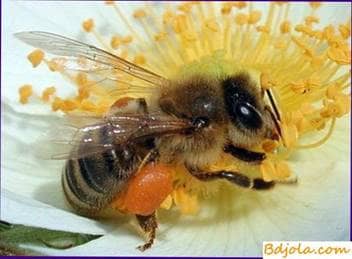
The break in honey collects negatively affects the development of bee colonies and their general physiological state.
The honey reserve of the area is distributed according to the flowering time of the honey plants: in spring, in summer, in autumn. To eliminate the impotent period, take into account the flowering period of the honeycombs and pollenots during these periods, and to improve the food base use all the possibilities in the radius of useful summer of bees. Improve the food base can be even in cities where junk wastelands are. Here, vines, rakits, male poplar are planted, such grassy meadows as phacelia, clover, bruise, sainfoin, etc., are scattered.
Choosing a honey culture for sowing, it must be borne in mind that the phacelia loves loose soils, so it can not be sown on not loosened soil. Yellow and white claws are not demanding for fertility, but they do not tolerate acidic soils. It is unpretentious to the soil bruise. The first flowers of bruise in the suburbs appear on the 2nd year after sowing, in the beginning of summer.
The best time for spreading seeds across waste grounds is late autumn, when seeds can not germinate until spring.
Deserves attention for planting in the front gardens, greenhouses and on the apiary itself, a mordant (ornamental plant), issuing a gentle, pleasant smell. Not everyone knows that the mordovnik is an excellent honey plant. He gives about 14 times more nectar than buckwheat. On each of its spherical inflorescences from morning till night, without interruption, bees actively collect nectar.
Many beekeepers in a small amount are grown on an insect balm. This is a comparatively mild honey: nectar with its flowers, bees take with difficulty, but the smell of lemon balm attracts and soothingly acts on the bees. Melissa is a perennial plant of the labiate family. Blossoms from the 2nd year after sowing. Melissa is very similar to the cat mint (or cat) – also a pleasantly smelling plant, less attractive to bees. You can distinguish them by the leaves and seeds. The leaves of the cat are ovoid-oblong, crenate-serrate, pointed at the tip, the leaves of lemon bald are somewhat larger and have a rounded shape, the melissa seeds are oblong, at the end with a white dot, and the cats have almost rounded. In the central belt and in the north of the country, lemon balm grows only on the cultivated soil, and the cat is everywhere.
It is noticed that the smell of the cat does not like mice and other rodents, so its cultivation near the winter quarters and other apiary premises is desirable.
A good initiative is shown by some beekeepers in planting greenery of estates, streets, small rivers, casing roads, strengthening ravines, dams, creating parks, using a variety of decorative and parked honey plants.
Important for bees are the places of growth of clover (creeping, hybrid, meadow), don-vika white, alfalfa (blue and yellow) peas (murine and finelygreen), hornfed, sage, oregano, cornflower, laurel grass, dandelion, kulbabs, etc. That is why we paid attention to the skilful selection of places for the apiary.
Unfortunately, the riches of meadow lands are rarely accessible to bees because of their use for grazing. Some areas of meadows are left specially for growing grass on hay, but mowing is usually carried out at the beginning of flowering plants. This prevents the natural seeding of meadows. As a result, from year to year, flowering honey plants fall out of the grass. This leads to depletion of the meadows. But even in this case, it is possible to improve the forage lands. In the interests of beekeeping, it is advisable to introduce more flowering legumes into the herbage, which, after flowering, do not lose fodder advantages for cattle.
To sow honey plants on fertile soils especially for bees is unprofitable. Often, melliferous plants are sown for feed to cattle (sainfoin, wool shaggy, wahoo dyeing, etc.), which are used as a green feeding, for silage or as a green fertilizer (phacelia, mallow, annual white clover).
Honey plants should also be included in feed mixtures. So, when sowing wicks and peas, they add a phacelia or mustard, which prevents the lodging of crops and facilitates their mechanized harvesting.
It is possible to carry out a joint mixed sowing of maize with a one-year-old white clover or a clover clover grass.
Usually the yellow clover blooms simultaneously with the linden. In order to prolong the honey harvest, in the case of the linden of nectar, the sweet clover is mowed higher before flowering. This delayed its flowering, which will take place after the end of flowering linden, i. e. in a time-free period.
Как дезинфицировать рамки. Весеннее кормление пчел.
Hothouse beekeeping